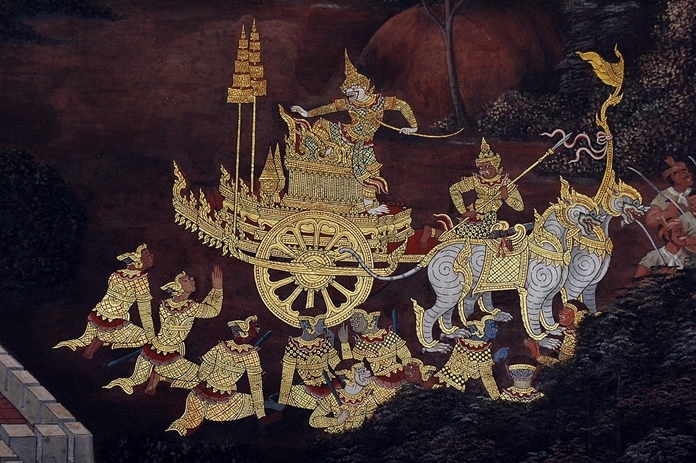
Lai lod nam is the Thai name for using gold leaf to illustrate scenes from Buddhist and Thai literature. It is a very complex process.
First, the outline of the picture is painted on a smooth wood surface to be used. The outline is done in a single colour, usually black. Every surface on which the artist desires gold is left unpainted. The paint on the outline is left to dry. After this is done, the whole surface, painted and unpainted, is covered with very thin gold leaf.
After a time, water is gently poured over the entire surface of the wood again and again. This causes the gold on the painted surfaces to fall off, leaving only the pictures. The process is long and complicated and delicate. Almost anyone can do it, but the real genius is in the artist’s execution. These pictures are fragile and exquisite. Most doors of important temples in Thailand are decorated with this method.
A devout Buddhist might want his or her devotion room’s walls decorated so. Some Thai people decorate their Too Phra Trai Pidok (large cabinets in which to keep the three books of Buddhist Scriptures) in this manner. Some also do the same with their smaller Klong Patimokh (a small Scripture box).
There is an artist in Thailand. You probably don’t know his name and probably never will, but he is the foremost practitioner of the Lai Lod Nam method of decoration in Southeast Asia. He is thoughtful and modest, and if you sit and talk with him for four or five hours, you will never hear the words Baht or ‘money’. Instead, he talks about his art.
His figures of humans and gods have personalities. They are vain, good, evil and playful. The animals in his work would have made Walt Disney jealous. Full of life, they are not so anthropomorphised that they are unbearably ‘cute’.
He is also Thailand’s leading traditional painter. His Thai style murals can be seen on the most important of Thailand’s temples.
This artist is also a teacher. He and his wife have from 10 to 20 students living with them at one time. They try to help him with money, but it is usually he who helps them.
Why doesn’t he teach at university? Because he is a genius but has no degree, so he cannot teach at university. Yet he is the chosen one, assigned to do most of the restoration work on Thailand’s important temples.
How do I know him? A few years ago a friend from an embassy called me. I knew she was an expert on Southeast Asian Art.
‘I need a favour,’ she said excitedly. ‘I was downtown and went into an art shop. I saw the most amazing scripture cabinet. They told me it’s 70 years old but I don’t believe it. Would you mind going and looking at it? Pretend you’re interested. They’ll probably offer you a better price.’
‘OK,’ I agreed, and went to the specified shop. I had no trouble in finding the cabinet. It was traditional. Following all the strict rules for this art, there were touches of originality which made one know that this cabinet was supposed to hold sacred objects. It was magic.
I received the same story from the owner. The cabinet was about 70 years old. He did not know who had made it. The price he quoted me was about half of what he quoted my friend.
When I called her back to report, she said, ‘I don’t believe a word. There’s an artist out there who probably is selling his work for nothing.’
My friend, a very resourceful person, had a young Thai assistant at the embassy. He was very familiar with old Thai art. She took Chart to the shop and he exclaimed, ‘I know this guy. He’s the best there is with this art form. Oh, but I can’t remember his name. Let me call a friend.’
Eureka! Chart’s friend knew the name of the artist, but had no idea where to find him, so the bloodhound work was assigned to me. I called a rather large government agency, who one would assume would know of this man. I asked for a contact address or phone number.
‘Why do you want to talk to him?’ he asked truculently. ‘We can make the cabinet for you.’
‘Uh, my friend is very picky and only wants this man’s work.’
The phone was slammed down.
After making about 12 calls I picked up the phone book. His name was listed. I called but the artist wasn’t in.
Two days later, he was in. ‘I was worried when you didn’t call back. You don’t want to study?’ he asked a bit disappointedly.
‘No, Acharn,’ I answered. ‘But a friend of mine would like you to make a cabinet for her. She wondered if you accept commissions?’
‘I’ll be glad to make you the cabinet, but it can’t be taken out of the country.’
‘I don’t understand.’
‘I really don’t enjoy talking on the phone,’ Acharn said. ‘We’re restoring a temple now. My wife and students are there all day with me. If you’d like to come and visit, you’re very welcome.’
The next day my friend and I were sitting on the floor of a very famous temple amid vats of paint and glowing waves of gold leaf.
‘You can make me a cabinet, but it can’t leave the country?’ my friend asked incredulously. ‘Why?’
‘Oh, it’s really a lot of nonsense. Let’s not talk about it.’
Acharn’s wife said a bit conspiratorially, ‘My husband is a genius at his art.’ I will tell you why he may not send his work out of the country.’
Continued next week….




